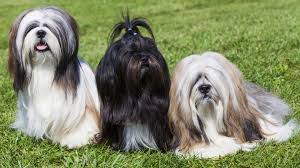Lhasa Apso Dogs: Description and Complete Care Guide
The Lhasa Apso is a charming breed of dog with a rich history and distinctive personality. Originally from Tibet, these dogs were bred to be loyal companions to Buddhist monks, and their unique traits have made them a popular breed among dog enthusiasts around the world.
One of the most notable features of the Lhasa Apso is their long, flowing coat. This coat is made up of a soft, woolly undercoat and a longer, coarser topcoat. The coat is typically thick and heavy, requiring regular grooming to prevent matting and tangling. While the coat can be difficult to manage, it is also one of the most striking aspects of the Lhasa Apso’s appearance, giving them a regal and dignified look.
In addition to their distinctive coat, Lhasa Apsos are also known for their unique personalities. They are often described as independent and stubborn, with a strong-willed nature that requires patience and persistence from their owners. While they can be aloof with strangers, they are fiercely loyal to their families and make excellent watchdogs.
Despite their small size, Lhasa Apsos are surprisingly sturdy and athletic. They have a high energy level and require regular exercise to stay healthy and happy. They are also intelligent and eager to please, making them excellent candidates for training and obedience work.
In terms of health, Lhasa Apsos are generally a robust breed. However, like all dogs, they can be prone to certain health issues, including hip dysplasia, eye problems, and allergies. Regular vet checkups and a healthy diet and exercise routine can help keep these issues at bay.
However, the Lhasa Apso is a unique and charming breed that requires dedicated care and attention from their owners.
Read Also: Yorkie Terrier: Description, Health, Origin and Complete Care Guide
History and Origin of Lhasa Apso Dogs

The Lhasa Apso is a small breed of dog that originated in Tibet. With their long, flowing coats and dignified demeanor, these dogs have become popular as both pets and show dogs. But how did this breed come to be? Let’s take a look at the history and origin of the Lhasa Apso.
The Lhasa Apso is believed to have originated in the city of Lhasa, the capital of Tibet. For centuries, these dogs were kept by Tibetan monks as guardians of monasteries and as companions. The Lhasa Apso was highly regarded by the monks, and they were often given as gifts to people of high status.
In Tibet, the Lhasa Apso was known as “Abso Seng Kye,” which roughly translates to “Bark Lion Sentinel Dog.” This name reflects the breed’s history as a guardian of monasteries and temples, where they would alert the monks to the presence of intruders.
The Lhasa Apso remained isolated in Tibet for many years, with little outside influence. It wasn’t until the 20th century that the breed was introduced to the rest of the world. In the 1920s, a few Lhasa Apsos were brought to England by travelers, and the breed quickly gained popularity. The first Lhasa Apso was registered with the American Kennel Club in 1935.
Despite their popularity, the Lhasa Apso faced some challenges in the early days of its introduction to the western world. Because the breed had been isolated for so long, it was prone to genetic disorders and health problems. To combat this, breeders began to carefully select which dogs were bred together to ensure the healthiest possible offspring.
Today, the Lhasa Apso remains a popular breed, known for its loyalty and regal appearance. They are often kept as pets, but can also excel in show competitions. In fact, the breed has won the coveted Best in Show award at the Westminster Kennel Club Dog Show four times, in 1941, 1959, 1984, and 2011.
In addition, the Lhasa Apso is a fascinating breed with a rich history. From their origins as guardians of Tibetan monasteries to their current status as beloved pets, the Lhasa Apso has come a long way. Despite facing some challenges in its early days, the breed has persevered and continues to be a popular choice for dog owners around the world.
Health Issues and Lifespan of Lhasa Apso Dogs

Eye problems: Lhasa Apsos are prone to a number of eye conditions, including cataracts, glaucoma, and progressive retinal atrophy.
Hip dysplasia: This is a common problem in many breeds, and Lhasa Apsos are no exception. Hip dysplasia is a condition where the hip joint doesn’t develop properly, leading to arthritis and pain.
Skin allergies: Lhasa Apsos are known to have sensitive skin, and they can be prone to developing allergies that can cause skin irritation and itchiness.
Respiratory problems: This breed has a short snout, which can make breathing difficult. They may be prone to respiratory problems such as wheezing and snoring.
It’s important to note that not all Lhasa Apsos will develop these health issues, and many can live long, healthy lives. The average lifespan of a Lhasa Apso is around 12-14 years, although some can live into their late teens.
To ensure that your Lhasa Apso stays healthy, it’s important to provide them with a nutritious diet, plenty of exercise, and regular veterinary check-ups. If you notice any changes in your dog’s behavior or health, it’s important to contact your vet right away. By taking good care of your Lhasa Apso, you can help ensure that they live a long and happy life.
Read Also: Selecting and preparing land for sweet potatoes planting
Lhasa Apso Dog Breed Complete Grooming and Care Guide

Brushing: Lhasa Apsos have a double coat, with a long outer coat and a soft, woolly undercoat. They require daily brushing to prevent matting and tangles. Use a slicker brush or comb to work through the coat, starting at the base and working your way up to the top. Be gentle and take your time to avoid hurting your dog.
Bathing: Lhasa Apsos don’t require frequent bathing, but you should bathe them every 2-3 months to keep their coat clean and healthy. Use a mild dog shampoo and avoid getting water in their ears. Dry them thoroughly after the bath to prevent skin irritation.
Nail trimming: Lhasa Apsos have fast-growing nails that require regular trimming. You should trim your dog’s nails every 4-6 weeks, or as needed. Be careful not to cut the quick, which is the pink part of the nail that contains blood vessels.
Ear cleaning: Lhasa Apsos are prone to ear infections, so it’s important to keep their ears clean and dry. Clean your dog’s ears once a week with a cotton ball or soft cloth and an ear-cleaning solution recommended by your vet.
Teeth brushing: Dental care is important for Lhasa Apsos to prevent tooth decay and gum disease. Brush your dog’s teeth daily with a dog-friendly toothpaste and toothbrush.
Exercise: Lhasa Apsos are a small breed, but they still require daily exercise to keep them healthy and happy. Take your dog for a walk or play with them in the backyard to get them moving.
Training: Lhasa Apsos are intelligent dogs that respond well to positive reinforcement training. Start training your dog early and be consistent with commands and rewards.
By following these grooming and care tips, you can help ensure that your Lhasa Apso stays healthy, happy, and looking their best. It’s also important to take your dog to the vet regularly for check-ups and vaccinations to maintain their overall health.
Where to Find the Lhasa Apso for Sale near Me/You

Breeders: A reputable Lhasa Apso breeder can provide you with a healthy and well-socialized puppy. You can find breeders through online directories, such as the American Kennel Club (AKC) or the Lhasa Apso Club of America. When choosing a breeder, look for one who provides health clearances for their dogs, has a clean and safe breeding environment, and is knowledgeable about the breed.
Rescue organizations: Lhasa Apso rescue organizations often have dogs of various ages available for adoption. These dogs may have been surrendered by their previous owners or rescued from shelters. Adopting a rescue dog can be a rewarding experience, but it’s important to be prepared for the potential challenges that come with adopting an adult dog.
Shelters: Local animal shelters may occasionally have Lhasa Apsos available for adoption. While you may not be able to find a specific breed at a shelter, you can often find loving and loyal dogs in need of a good home.
Online classifieds: There are a number of online classifieds websites, such as Craigslist or Facebook Marketplace, where people may advertise Lhasa Apsos for sale. However, it’s important to be cautious when purchasing a dog through these channels, as some sellers may not be reputable or may not have the best interests of the dog in mind.
When searching for a Lhasa Apso for sale, it’s important to do your research and choose a seller or organization that is reputable and has the best interests of the dog at heart. Make sure to ask questions, see the puppies or dogs in person, and gather as much information as possible before making a purchase or adoption.
Read Also: The Devastating Water Pollution Consequences









